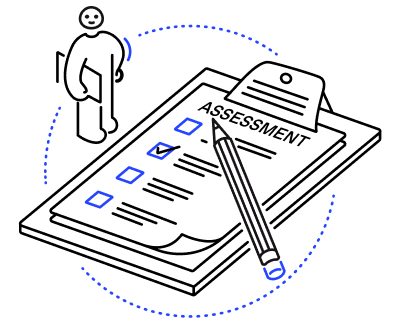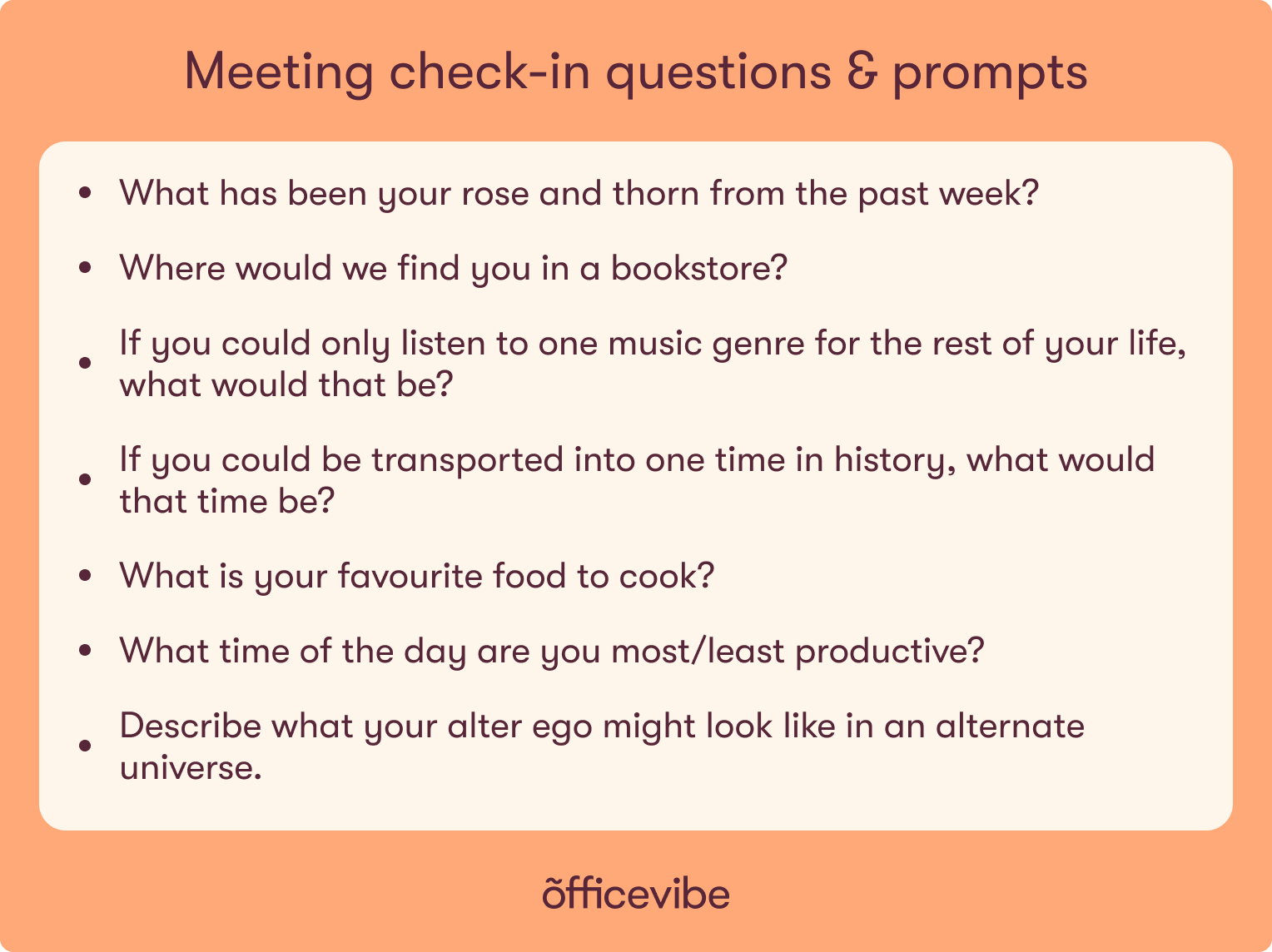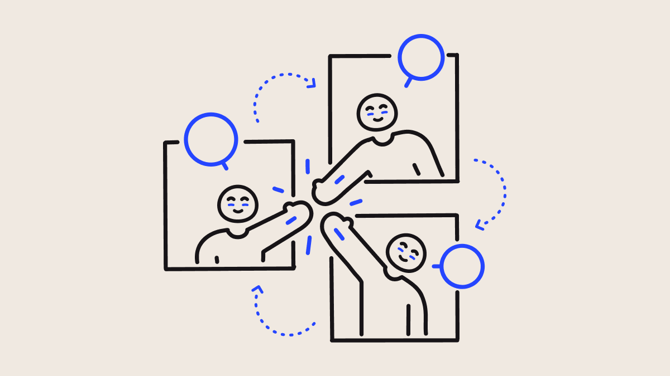Most experienced managers understand just how important fostering trust, connection, and collaboration is if they want to run a high-performing team. For many remote teams, meetings are a chance for employees to nurture those important human connections. Unfortunately, our increasingly busy schedules make it tempting to dive right into business, skipping over the casual conversation we might have once had when face-to-face.
Do you love catching up with your colleagues, but feel pressured not to waste precious meeting time? Do you miss the meaningful exchanges you once had at the office?
Cue in the meeting check-in! A meeting check-in is an intentional practice of “checking in” before a meeting begins, rather than just jumping into your agenda points. Meeting check-ins have become such a prominent part of our new virtual world, and we want to help you make them meaningful and efficient, to help balance your team's human and professional priorities.
Assess your organization’s employee experience in minutes

What's in this article
What is a meeting check-in?
A meeting check-in is a chance to casually touch base at the start of a meeting, and get a sense of how everyone is joining the call. There are several different ways you can check-in, including:
- Mindful minutes (pausing for a few deep breaths before beginning)
- Asking funny questions to build rapport between colleagues
- Providing status updates on how people are feeling
Checking in before a team meeting or 1-on-1 meeting invites people into the conversation, and gives them the opportunity to switch their focus onto the present moment. This is important, as many of us run from meeting to meeting all day without taking time to pause.
Check-ins can be done by anyone on the team. If you’re managing the team, you can lead them, or, delegate a new person each week to lead the check-ins.
Why you should have check-ins
Starting a meeting off with a quick check-in helps set the tone and gives everyone a chance to connect. In a remote environment, meeting check-ins can be an effective way to balance our need to socialize.
While you might be tempted to dive right into business, taking the time to check in and see how people are doing signals safety to your employees. It opens the floor to share and gives everyone in the room permission to speak up right from the start. And teams who experience a higher degree of psychological safety reap the benefits of productivity, innovation, and trust.
By skipping over the check-in, you may inadvertently indicate to your team that there is no time or space for personal connection at work. Leaving time to connect at the human level creates the opportunity to reinforce and nurture that psychological safety your team might be missing, as they don’t currently have the opportunity to engage in coffee or water cooler chat.
6 Effective meeting check-in tips
Check-ins, when planned well, can bring value to a team’s dynamics and build connections, rather than feel like time wasted. These tips will help you have better meeting check-ins with your team.
1. Make it personal
You’ll want to find the sweet spot when it comes to personalizing your check-ins. Questions like “How are you doing” can get tiring and feel inauthentic. When surface-level check-ins are happening multiple times a day, it can start to feel like it’s taking away from precious collaboration and work time, hindering productivity.
Aim for thoughtful, open-ended questions and mindfulness prompts:
- What’s one thing you’re grateful for today and why?
- Name one remarkable thing that you did today.
- What’s something nice you’re doing for yourself this week?
- Share one thing that helps you feel grounded during the day.
2. Have some fun
Check-ins with clear, engaging questions can be both fun and effective. If you want to take your personalized questions a step further, get into more ice-breaker-style questions that give your employees space to have fun and think about non-work-related topics.
Try some outside-of-the-box questions or check-in prompts:
- Name 3 itemsyou always keep close to your desk and share why.
- Would you rather be able to read minds or see the future?
3. Keep it time-bound
A great question can spark great conversation. While you don’t want to interrupt a fun discussion, it’s also necessary to keep your meetings on track. As a rule of thumb, you can try to keep your check-ins to 5 minutes. Based on how many people you have on your team, you can let employees know ahead of time how long they will each have to answer.
One-liners to stick to a timeframe:
- “Let’s go around and answer the following question. Everyone will get 30 seconds each to share.”
- “Thanks so much for sharing! In the spirit of getting through our agenda, let’s move on to the next person.”
4. Decide your cadence
If you meet with your team 3 times a day, starting off each meeting with a fun question might seem like overkill. Set a cadence of when you want to have meeting check-ins that makes sense for your team's context. Be sure to share this with your team so everyone is on the same page.
Good moments to have a meeting check-in:
- The first team meeting of the week
- Retrospective meetings
- 1-on-1 meetings
- Meetings with teams or employees you don’t work with often
5. Try it async
If your team is scattered in different time zones and live meetings are scarce, you can make your check-ins asynchronous. Get in the habit of posting a 'Question of the day' on Slack, and ask everyone on your team to answer the question as they log in and start their days. This provides an opportunity for people to connect personally, wherever they are.
Asynchronous check-ins for distributed teams:
- When and where do you do your best work?
- Where do you most want to travel?
- What does utopia look like for you?
6. Focus on psychological safety
Remember to make this a safe space for your employees, and make every meeting check-in completely optional. Whether people don't have an answer, don't want to be put on the spot, or simply don't feel like participating that day, they should be able to simply say 'pass' without further explanation. Remind your team that these questions are in no way mandatory to answer should they prefer not to participate.
A safe space for meeting check-ins looks like:
- Not passing judgment or criticism on anyone's answer.
- Never forcing someone to answer.
- Not making it too personal or crossing personal boundaries.
Meeting check-in questions and prompts
We compiled some of our favourite meeting check-in questions and prompts, that you can easily save for future use. Drag to your desktop or right-click and save, and/or send them to your email.

Make every meeting check-in meaningful
Checking in with your employees is a crucial part of building trust, connection, and creating a comfortable rapport on the team. While it may be tempting to skip over this step and jump right into business, building check-ins as a regular practice will help contribute to a team culture of psychological safety, human connection, and fun! What check-ins will you be trying out in your next meeting?
Get more meeting check-in ideas from our 1-on-1 meeting templates.
Equip HR and managers with tools to engage, recognize, and drive performance.




